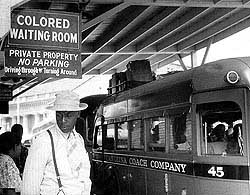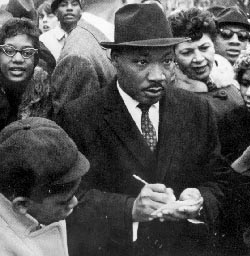Click
Here to return to the previous page
Paul Sparks
- Online English Lesson Plans, Lesson Material and Ideas for "Culture of
English Speaking Countries Lessons" for Xiangtan Normal University...
WESTERN CULTURE AND SOCIETY: THE UNITED STATES OF
AMERICA (USA) -
American Social Movements of the 1960's
Background to the Social Movements:
-
At the beginning of
the 1960's black and white people were treated differently. There were
laws to say that they had to use different shops, services, transport,
schools etc. These laws were known as Segregation laws. Women were also
treated in a very different way to men.

-
On 1st February
1960, 4 freshmen from a black college in Greensboro, North Carolina,
went to a store and sat down for lunch. The waitress said she could not
serve "people like them" (See the picture). The students
believed that the law which kept black and white people separate when
eating was wrong, so they would not move. The police came, but the
students continued to sit down, more people came to join and the next
day there were many people there. Each day more black students joined
and started a quiet "sit-in". This began the Civil Rights
Movement of the 1960's.
-
During the first
twelve months of the 1960's over 50,000 people took part in
demonstrations in America, over 3,600 were jailed. But by the end of the
1960's food places were open to people of all colours or nationalities.
-
Other civil rights
movements began, including anti-war groups and women's rights
demonstrations.
-
In September 1961
the federal government declared segregation illegal on all state bus
services.

-
In the summer of
1963 hundreds of thousands of peaceful demonstrators went to Washington
DC, where Martin Luther King gave a famous speech "I have a
dream...". He was given the Nobel Peace Prize in December 1964.
-
To improve racial
relations in America, the Civil Rights Act was passed by congress and
signed by President Johnson in the summer of 1964.
-
In 1965 President
Johnson began a "War on Poverty"
-
Martin Luther King
was assassinated in April 1968, which lead to trouble throughout
America, with riots in 125 separate cities.
Conclusions:
-
Legal segregation
ended as a result of the civil rights movement, all Americans have the
right to vote, regardless of their skin colour. However, racism is still
a big problem in many areas in America. The anti-war groups forced a
peace treaty to be signed between America and Vietnam in 1973. Women's
rights movements continued to give women equal rights. The social
movements of the 1960's had a strong effect on the way people think and
act, and caused changes in many laws.
Martin Luther King, Jr.
Biography (1929-1968): One of the most
visible advocates of nonviolence and direct action as methods of social
change, Martin Luther King, Jr. was born in Atlanta on January 15, 1929.
After attending Morehouse College in Atlanta, King went on to study at
Crozer Theological Seminary in Pennsylvania and Boston University, where he
deepened his understanding of theological scholarship and explored Mahatma
Gandhi's nonviolent strategy for social change. King married Coretta Scott
in 1953, and the following year he accepted the pastorate at Dexter Avenue
Baptist Church in Montgomery, Alabama. King received his Ph.D. in systematic
theology in 1955.
 On
December 5, 1955, after civil rights activist Rosa Parks refused to comply
with Montgomery's segregation policy on buses, black residents launched a
bus boycott and elected King president of the newly-formed Montgomery
Improvement Association. The boycott continued throughout 1956 and King
gained national prominence for his role in the campaign. In December 1956
the United States Supreme Court declared Alabama's segregation laws
unconstitutional and Montgomery buses were desegregated. On
December 5, 1955, after civil rights activist Rosa Parks refused to comply
with Montgomery's segregation policy on buses, black residents launched a
bus boycott and elected King president of the newly-formed Montgomery
Improvement Association. The boycott continued throughout 1956 and King
gained national prominence for his role in the campaign. In December 1956
the United States Supreme Court declared Alabama's segregation laws
unconstitutional and Montgomery buses were desegregated.
Seeking to build upon
the success in Montgomery, King and other southern black ministers founded
the Southern Christian Leadership Conference (SCLC) in 1957. In 1959, King
toured India and further developed his understanding of Gandhian nonviolent
strategies. Later that year, King resigned from Dexter and returned to
Atlanta to become co-pastor of Ebenezer Baptist Church with his father.
In 1960, black college
students initiated a wave of sit-in protests that led to the formation of
the Student Nonviolent Coordinating Committee (SNCC). King supported the
student movement and expressed an interest in creating a youth arm of the
SCLC. Student activists admired King, but they were critical of his top-down
leadership style and were determined to maintain their autonomy. As an
advisor to SNCC, Ella Baker, who had previously served as associate director
of SCLC, made clear to representatives from other civil rights organizations
that SNCC was to remain a student-led organization. The 1961 "Freedom
Rides" heightened tensions between King and younger activists, as he
faced criticism for his decision not to participate in the rides. Conflicts
between SCLC and SNCC continued during the Albany Movement of 1961 and 1962.
In the spring of 1963,
King and SCLC lead mass demonstrations in Birmingham, Alabama, where local
white police officials were known for their violent opposition to
integration. Clashes between unarmed black demonstrators and police armed
with dogs and fire hoses generated newspaper headlines throughout the world.
President Kennedy responded to the Birmingham protests by submitting broad
civil rights legislation to Congress, which led to the passage of the Civil
Rights Act of 1964. Subsequent mass demonstrations culminated in the March
on Washington for Jobs and Freedom on August 28, 1963, in which more than
250,000 protesters gathered in Washington, D. C. It was on the steps of the
Lincoln Memorial that King delivered his famous "I Have a Dream"
speech..
King's renown continued
to grow as he became Time magazine's Man of the Year in 1963 and the
recipient of the Nobel Peace Prize in 1964. However, along with the fame and
accolades came conflict within the movement's leadership. Malcolm X's
message of self-defense and black nationalism resonated with northern, urban
blacks more effectively than King's call for nonviolence; King also faced
public criticism from "Black Power" proponent, Stokely Carmichael.
King's efficacy was not
only hindered by divisions among black leadership, but also by the
increasing resistance he encountered from national political leaders. FBI
director J. Edgar Hoover's extensive efforts to undermine King's leadership
were intensified during 1967 as urban racial violence escalated, and King's
public criticism of U.S. intervention in the Vietnam War led to strained
relations with Lyndon Johnson's administration.
In late 1967, King
initiated a Poor People's Campaign designed to confront economic problems
that had not been addressed by earlier civil rights reforms. The following
year, while supporting striking sanitation workers in Memphis, King
delivered his final address "I've Been to the Mountaintop." The
next day, April 4, 1968, he was assassinated.
To this day, King
remains a controversial symbol of the African American civil rights
struggle, revered by many for his martyrdom on behalf of nonviolence and
condemned by others for his militancy and insurgent views.
|